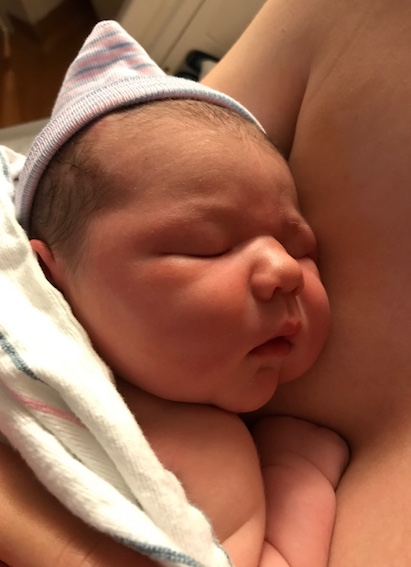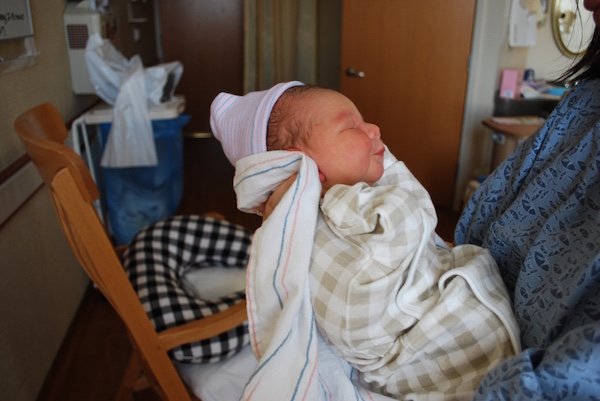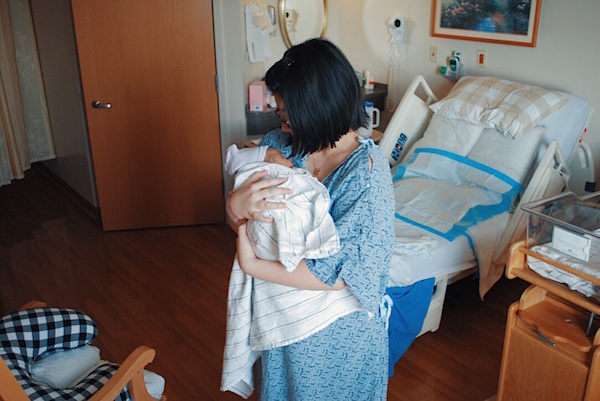A matter of time: The birth of Arlo

The logical side of my brain knew that my due […]
The logical side of my brain knew that my due date was far from a guaranteed deadline. I tried to mentally prepare myself for going past June 23 and often joked that my baby would probably be tardy to the party. I was being smart. I wasn’t going to get my hopes up.
Then at my 38-week appointment, I had my first cervical check. I’d had zero contractions—or none that I could confidently identify, so my OB and I were both stunned to discover I was already dilated 2 centimeters and 60 percent effaced. And that’s when my logic flew right out the exam room window.
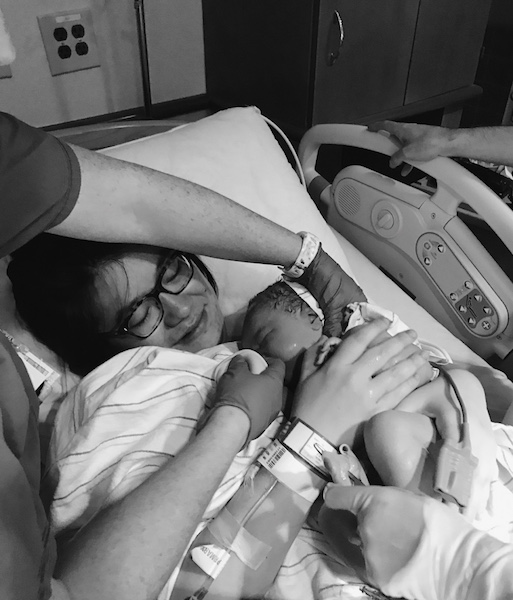
From that point on I still talked the talk of remaining calm, but I was secretly convinced this baby was coming soon. My husband, Lee, and I tried almost every natural induction method we’d heard about. I even had eggplant parmesan from a restaurant with a reputation for sending women into labor.
On one of our many evening strolls, when I was 39 weeks, I felt light cramping but didn’t think much of it. As we made our way up the biggest hill along our path, I found myself slowing and eventually stopping to focus and breathe through what I realized was a contraction. We still had another mile to go, so I trudged on, pausing when I needed to. The contractions were coming regularly and steadily getting closer together. Lee and I looked at each other wide-eyed and smiled. This was it.
When we got back to the house, Lee tossed a few last-minute things in the labor bag while I rocked on my birthing ball. We were already discussing when we should text our doula to fill her in on what was happening, but before we could settle the matter I noticed my contractions easing up. I tried pacing around the house to keep things rolling, but that was that. Instead of heading to the hospital, we went to bed.
That cycle of prodromal labor repeated itself so many times in the following days that I began to lose hope this baby would ever budge. I often felt contractions in the evenings. They would steadily increase in frequency, duration and strength—but then they’d peter out after two hours or so. It was tough to not be discouraged because not only do contractions take it out of you physically, but thinking you’re about to meet your baby—and suddenly not—also takes a toll emotionally.
Once I hit 40 weeks, I was having twice-weekly appointments with my OB. At each one I had a pelvic exam because I felt like I needed reassurance, but there was never any dramatic change. At one my OB told me I was “a tight 3” centimeters. Honestly, I think she just felt bad telling me yet again that I was at 2. She added that my cervix was very soft and things would likely progress quickly once real labor started. Everything seemed ready to go, but things just weren’t going.
Being past due also meant I had one more ultrasound. My fluid level was borderline low, so my doctor brought up induction. She knew I wanted to try to deliver with as few interventions as possible, but she preferred that I have my baby sooner rather than later. Because of the Fourth of July holiday, I managed to push the induction to July 6. Lee and I were instructed to be at the hospital the night before to get ready.
According to plan
Once we had a date set, I hoped I’d relax, and maybe—just maybe this kid would come on his own. But by the night of July 4, I’d accepted that my labor would start in the hospital. Lee and I spent the evening trying to spot fireworks from the comfort of our couch. It was there that I finally felt at peace about it all. I wasn’t trying to change things. I was just ready for the next day, so I could meet my baby.
Even though I wasn’t going to the hospital until that night, Lee took the day off work. (I think he knew watching the hours tick by alone would be torture for me.) We made the most of our last day just the two of us and tidied the house, cuddled with our pup and had a lunch date.
At 5 p.m. I called the hospital to ask when they wanted us to arrive. Half of me was nervous and wondering if I’d be able to handle the pain of Pitocin-induced contractions while the other half of me was eager to get this show on the road. It had been long enough.
I soon found out it would be a bit longer because the labor and delivery ward was packed, as the nurse on the phone informed me. There wasn’t a single available room, so I was told to call back around 10 or 11 p.m. I felt deflated yet again, but I reminded myself that soon I’d find out if I had a son or daughter.
Not to sound completely uncool, but 10 p.m. is past my usual bedtime. I considered trying to nap, but my nerves wouldn’t let me. When I called back, I was surprised when the nurse immediately asked, “Are you ready to have a baby?” I said, yes, and she told me to be there within the hour.
We live precisely two minutes from the hospital—one if you don’t hit any red lights. So, I took a long shower to relax before we loaded up the car. As we glided out of the driveway, the roads were empty. We marveled at the fact that it was really happening. It felt so strange. We were on the way to have our baby, but this drive was not at all how I imagined it would be. I had wanted to labor at home for as long as possible, so I thought this trip would be dramatic and hurried. I’d pictured myself groaning in the back seat on a towel in case my water broke. But there I was sitting, as comfortably as you can at 41 weeks and six days, in the passenger seat, calmly chatting with my husband. I teared up a little at this point because I knew that the drive to the hospital wasn’t the only thing that would be different than I had hoped.
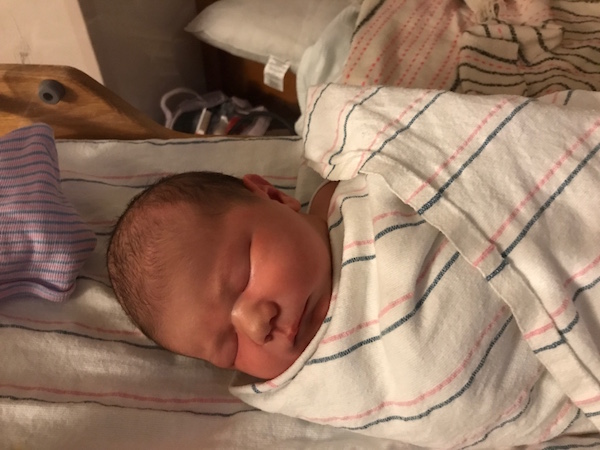
We parked, grabbed our bags and the birthing ball, and made our way to the registration desk. Forms were signed, I was given a hospital bracelet, and then we were told to do what we had become very accustomed to: have a seat and wait.
I was first on the induction list because I was so far past my due date, but even that didn’t matter when women were rushing in clearly in the throes of labor. They needed a room far more than me, the quiet pregnant lady in the corner. So, for the next hour, we watched five women come in and be escorted through two large double doors. Eventually, it was our turn.
Here’s when the first surprise of the evening came. After I changed into my gown, the nurse came in to start my IV of fluids. (I also had to have blood drawn for the group b strep test because the one I’d had at my OB’s office had been too long ago … because I was two weeks past due. Great.) The nurse then said she’d be back to start Pitocin at 1 a.m. Wait, what?!
I was under the mistaken impression that I would have Cervidil first, which would be inserted and left overnight to ripen my cervix, then Pitocin in the morning. When I brought this up, my nurse said that she spoke to my OB on the phone and was told to go straight to Pitocin because my cervix was already soft. Um, OK.
I had expected to have a night’s sleep before starting the hard work of labor, but once again things weren’t going according to the plan in my head. I did have about an hour to try to nap, but at this point I was wound up and wide awake. I did my best to close my eyes and get some semblance of rest, if not actual sleep. But the enormous clock directly across the room from my bed was a constant distraction.
When the nurse came in with the bag of Pitocin, I timidly asked how soon I could expect to feel contractions. She said they start pretty quickly—for some it’s a half hour, for others it’s almost immediately. (Looking back, I wish I hadn’t asked because all I did was anxiously wait for the pain to kick in. And her answer didn’t even hold true for me.)
The nurse started at the lowest dose, 2, and said she’d bump it up every 30 to 45 minutes. By 6 a.m. when my OB arrived, the Pitocin pump read 8. I was having minor contractions on the monitor but still wasn’t feeling them. I heard my doctor tell the nurse that I couldn’t have a baby if I wasn’t feeling any contractions. That’s when they really cranked things up.
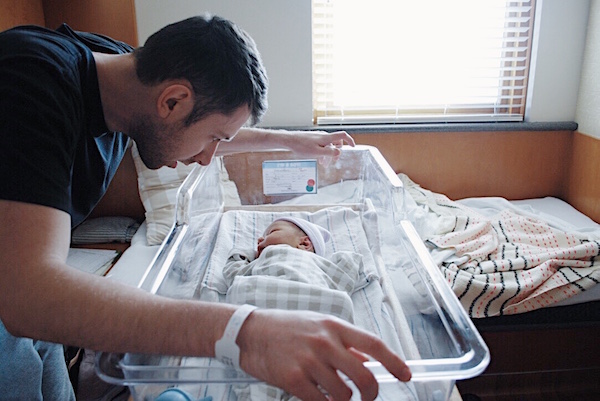
Not long after, I felt my first contraction. This is where the second surprise comes in. Instead of it feeling like the many contractions I’d had over the past two weeks, the pain was concentrated entirely in my lower back. Yep, I had back labor.
The contractions became very intense, very fast. Up to this point, I’d been sitting in the bed. As the pain increased that became nearly impossible. I found I was most comfortable sitting on my ball leaning forward with my elbows on the side of the bed. When a contraction hit I’d hang my head between my arms, sway on the ball and vocalize through it. Normally I’m a very shy person, so I wondered if I’d be too embarrassed to make a peep during labor. I wasn’t. I didn’t care in the slightest who heard me.
By around 9 a.m., I guess I was making enough of a ruckus. I overheard the nurse suggest to Lee that it might be time to call our doula. (We’d been looping her in on my progress, and she was on standby.)
Our doula, Danielle, arrived about an hour later. Before she walked in the door, the pain was beginning to wear on me, so I was thrilled to have reinforcements. I am not at all exaggerating when I say she was exactly what I needed at that moment. Within the first 10 minutes of being there she had cold wash cloths on my neck and back, and she was countering the pressure of contractions—all still in my back—with hip squeezes, which made a world of difference.
I was laboring in my back because the baby was positioned sunny side up, so Danielle suggested a few different positions to flip the baby around. We tried those (and when I say we, I mean Danielle, Lee and me; it was a serious group effort) until I was tired and needed a break.
Once I was in the thick of labor, I kind of lost track of time, and the details get a bit fuzzy. I remember at one point Danielle encouraged Lee to step out, catch his breath and grab some lunch. She also asked when was the last time I had eaten, which was 8 p.m. the night before. Since then it had been water and ice chips. She gave me a honey stick for a jolt of energy, and a little later I remember her bringing me a small cup of broth to sip.
The nurse was having trouble getting a reading on my contractions, so during all of this she would periodically come in to readjust or have me lie in bed for a few minutes. Lying on your back with back labor is the absolute worst. I’d jump back on my birthing ball as soon as I could. The movement really seemed to help me cope.
As contractions intensified, they were so frequent that they were practically one on top of another. I hardly had time to catch my breath before the next one would overtake my body. This ended up being worse, in my opinion, than any amount of pain I was feeling. During my birthing class, one of the points that resonated most with me was the fact that there was always a rest period between contractions. I had planned on focusing on this brief break to help me get through labor. Knowing that each contraction had to end and that at that end point I’d have a couple of minutes to regroup made me feel like I could handle the uncertainty of labor by breaking it down into manageable pieces. But suddenly I didn’t have those breaks I’d counted on.
I don’t know exactly how long I powered through back-to-back contractions, but it felt like hours. I’d dilated to 6 centimeters but stalled there. My mind couldn’t let go of the thought that there was no rest in sight. Who knew how long it would take me to get to 10 centimeters at this rate? I knew I couldn’t keep going without some sort of change. At this point, I talked to my doula about my pain relief options. I decided to have a dose of fentanyl. I was warned that it wouldn’t eliminate pain entirely and also wouldn’t last very long, but I would take what I could get.
When the fentanyl wore off 30 minutes later, the contractions returned in full force. I handled them as best I could for a while, but I think everyone in the room could sense I was losing my ability to focus. Danielle suggested trying a new position kneeling on the bed and draping myself over the back. It didn’t last long.
I could tell I was approaching my breaking point because I could no longer keep my vocalizations deep and low, like I practiced in class. I felt tears burn in my eyes for the first time. I was internally struggling to actually ask for an epidural because it wasn’t what I wanted. Honestly I felt like I was letting down myself, my husband and even my doula. I had practiced pain management techniques. I’d taken a 16-hour natural-focused birthing class. I’d told so many people that I wanted to deliver without pain meds. It was hard to let go of all of that and say the words out loud, but I knew I needed to. I knew that if I kept going I’d be too exhausted to push the baby out, and the last thing I wanted was to end up with an emergency C-section. So, I looked at my doula and said, “I can’t do this anymore.”
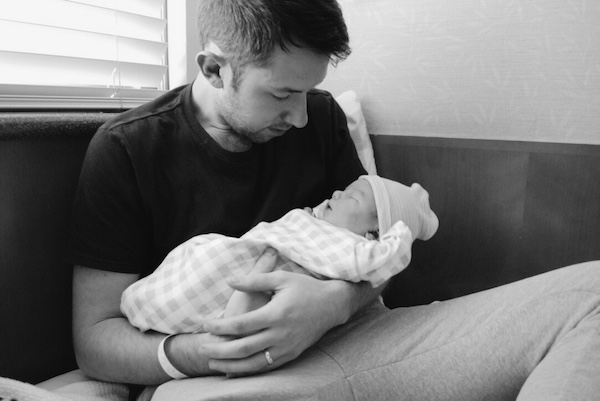
I am so grateful that she didn’t show a flicker of disappointment on her face. Danielle simply asked what I wanted to do, and when I said I wanted an epidural, she said OK.
From there things happened quickly. The anesthesiologist arrived in minutes. I was mid-contraction when he walked in, and he tried to wait until it was over before he explained what he’d be doing. But he soon realized that there wasn’t time for that before another contraction started. So he talked through them and instructed me to sit on the edge of the bed and lean forward. I had to hold still while he placed the epidural, which was difficult without a break between contractions. I’m not sure how I did it, but I did.
I remember someone asking if I could still feel my legs and someone lowering the bed to let me lie down. That’s it. Apparently I was so exhausted after being up for more than 30 hours, not eating all day and working through contractions that as soon as I couldn’t feel the pain I immediately fell into a deep sleep. I hadn’t realized how tired I was because I was so focused on labor, but in hindsight I’m glad I was able to rest before pushing.
The next thing I knew I was opening my eyes (this was when I realized I had fallen asleep) to hear my OB and nurses talking. I looked to my left to see Lee and Danielle sitting and chatting quietly. Then I overheard my doctor, who was busy between my legs, say something about being “complete” and “ready.” Danielle perked up when she heard it, too.
“What did you say?” I asked. I was still foggy from just waking up, so I was certain I’d misheard something.
“You’re at 10 centimeters,” my OB said with a smile.
I was completely caught off guard. I had no clue how long I’d been snoozing, but it seemed impossibly soon to reach the pushing stage. (I later found out it had been only an hour.) Realizing that my life was about to change forever, I took a deep breath. I was about to meet my baby.
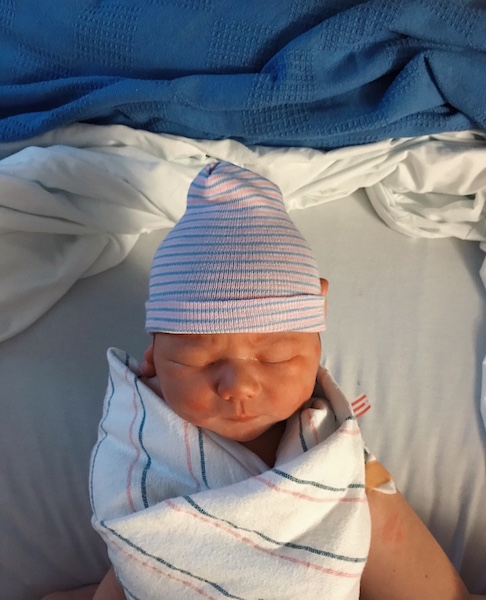
I was stunned but giddy—so much so that my OB said, “There’s the Chantel I know.” I hadn’t smiled all day (labor will do that), but I was grinning like a fool.
A nurse raised the back of my bed and pulled out the leg braces. My OB told me to use them in between pushes—not during—to rest my legs. She went on to explain that I should take a deep breath and bear down to push as I exhaled slowly for a count of 10. We’d do that two or three times during a contraction, and she’d let me know when to start (because I couldn’t feel the contractions).
With my hands on the back of my thighs, I pulled my knees to my chest and tried to follow her instructions. It took me a couple of pushes to get the hang of it. The first time I held my breath. The second I exhaled way too fast. But slowly I found my rhythm.
My doula was on my right side helping to hold my leg. Lee was doing the same on my left, but he was nearer my head than the business end of birth. (He gets queasy in medical situations.) He went into this thinking he’d wait and see the baby after the birth, not during. But it didn’t take long for him to change his mind when my OB and doula exclaimed that they could see a head.
I reached down to feel (also something I wasn’t planning on doing), and I remember being so surprised at how soft it was—and also that it was already there. I’d only pushed a handful of times.
Pushing is hard work, but in a way I preferred it. I was no longer trying to endure. Instead I was actively doing something to bring my child into the world. And having my birth team cheer me on motivated me to give it everything I had.
After a mere 20 minutes, my baby’s head was out, and in the next push my little one was in my OB’s hands. She held the baby up for us to see. The very first thing I noticed was that he was a boy. A split second later Lee announced, “It’s a boy!” We’d waited nine long months to find out that we had a son. Arlo Jack Newton was born at 4:30 p.m. on July 6.
The second thing I noticed (though it all happened much faster than it sounds) was his size. I couldn’t believe that he had been inside of me moments earlier or that he even fit in there at all.
My OB handed him straight to me. I think I mumbled, “It’s you.” But maybe I just thought it. He was a gray purple-ish color, and he was slippery. I cried as I held him against my chest and stared at him, learning his face, his tiny features. He was perfect in every way.
Arlo didn’t cry at first, but once he found his little voice, he didn’t hesitate to use it. I comforted and snuggled him while the nurses and doctor did their thing. I was so wrapped up in him, though, that I didn’t really see, hear or even notice anything else. It was almost like the rest of the world blurred, and it was just Lee, me and our baby boy. (I got a recap later: Lee cut the umbilical cord. My OB stitched up two small tears—one first degree, one second.)
My doula asked if I wanted to try nursing, and Arlo latched on with minimal fuss. It was such a surreal feeling to be holding him in my arms and feeding him.
When a nurse took Arlo to perform a few assessments in the corner of the room, we learned that our chunky monkey weighed 9 pounds, 4 ounces, and he measured 21 inches long.
During this time, I chatted with my doula and OB. We were all smiles. My doctor said she was impressed by how well I pushed as a first-timer with an epidural. (I used the How to Push Out Your Baby app to “practice” during my final weeks of pregnancy, and I really do believe that made a difference.) She also told me that she knew things would happen quickly once I had the epidural because my body was so tense trying to cope with nonstop contractions that I couldn’t relax enough for my cervix to open. But she held off suggesting an epidural because she knew I wanted a natural birth. Looking back, I think she was right, though I’m grateful she allowed me to ask for an epidural on my own.
From beginning to end, Arlo’s birth story is nothing like what I thought it would be. It was a day filled with surprises, sweat, tears and so much love that I forgot all the rest. As I sit here, my newborn grunting softly beside me, I can’t help but think that motherhood will be a lot like that.
Send us your birth story! Whether you had a home birth, hospital birth, 37-hour labor or emergency C-section, we’d love to read the tale of your little one’s grand entrance. Write up your birth story (click here for tips on getting started) and email it, along with a few photos, to birthstory@pnmag.com. We’ll share it on our Birth Day blog and may even print it in an upcoming issue.


